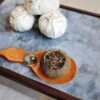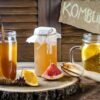
Nestled deep within the lush landscapes of South America lies a centuries-old tradition that captivates the senses and nourishes the soul. It is the tradition of Yerba Mate tea, a drink with a history as rich and vibrant as the regions it hails from. Enthusiastically steeped in cultural significance, this ancient beverage has become an integral part of the social fabric of communities spanning Argentina, Uruguay, Paraguay, and southern Brazil.
Known for its invigorating properties, Yerba Mate tea has long been celebrated for its ability to provide a unique combination of caffeine and a variety of beneficial compounds, all while encouraging a sense of connection and camaraderie among those who partake in its communal consumption. From the elaborate rituals that surround its preparation to the deep-rooted traditions that dictate its serving methods, Yerba Mate tea represents more than just a simple beverage – it is a journey to the heart of South America, an exploration of a time-honored tradition that continues to endure.
Join us as we delve into the history, culture, and health benefits of Yerba Mate tea, and uncover the secrets that have made it a beloved tradition for generations. Embark on a journey that transcends borders and awakens the senses, as we unveil the captivating story behind this ancient South American brew.
The history and cultural significance of Yerba Mate
Yerba Mate tea has a long and storied history in South America, dating back to the indigenous Guarani people who first discovered the leaves’ invigorating properties. The Guarani believed that Yerba Mate was a divine gift from the gods, and they used it for its medicinal properties as well as for social and spiritual purposes. As European settlers arrived in South America, they were quickly introduced to this unique beverage and, over time, it became an integral part of the region’s cultural identity.
Yerba Mate tea is deeply intertwined with social customs and traditions in South America. It is often shared among friends and family, with the act of drinking Mate becoming a communal experience. The traditional gourd and bombilla, a special straw used to drink the tea, hold great cultural significance and are often passed down through generations. The act of sharing Mate is seen as a symbol of friendship, trust, and hospitality, and it is not uncommon to see groups of people gathered around a shared gourd, engaging in conversation and connection.
Yerba Mate tea is also an important part of social gatherings and celebrations. It is often served during special occasions such as weddings, birthdays, and holidays, where the act of sharing Mate fosters a sense of unity and togetherness. The rituals and customs that surround the preparation and serving of Yerba Mate tea are deeply ingrained in the cultural fabric of South America, creating a sense of tradition and continuity that has endured for centuries.
Health benefits of Yerba Mate Tea
Beyond its cultural significance, Yerba Mate tea is celebrated for its numerous health benefits. Packed with vitamins, minerals, and antioxidants, this ancient brew offers a range of advantages for both the mind and body.
One of the key benefits of Yerba Mate tea is its ability to provide a gentle energy boost without the jitters often associated with coffee or other caffeinated beverages. The caffeine in Yerba Mate is released slowly, resulting in sustained energy levels and increased mental focus. Additionally, Yerba Mate contains theobromine, a compound that promotes a sense of relaxation and mental clarity, making it an excellent choice for those seeking a balanced and natural energy source.
Yerba Mate tea is also known for its abundant antioxidant content, which helps protect the body against oxidative stress and inflammation. These antioxidants can support a healthy immune system, improve digestion, and contribute to overall well-being. Furthermore, Yerba Mate has been shown to have potential cardiovascular benefits, such as reducing cholesterol levels and improving heart health.
How to prepare and drink Yerba Mate
Preparing and drinking Yerba Mate tea is an art form in itself, with a set of customs and rituals that have been passed down through generations. To prepare Mate, one must start with a traditional gourd, which is often made from a hollowed-out calabash fruit, and a bombilla, a metal straw with a filter on one end.
To begin, the gourd is filled about two-thirds full with Yerba Mate leaves. The leaves are then gently shaken to allow the finer particles to settle at the bottom of the gourd, creating a natural filter. The bombilla is inserted into the gourd, with the filter end touching the leaves. Hot water, typically around 70-80°C (160-180°F), is poured into the gourd, allowing the tea to steep. The Mate is then sipped through the bombilla, and the process is repeated until the tea loses its flavor.
Drinking Yerba Mate is not simply about consuming a beverage; it is a mindful and communal experience. The gourd is often passed around in a clockwise direction, with each person taking turns to drink from the same vessel. This ritual fosters a sense of connection and unity among those partaking in the Mate circle, promoting conversation and creating a space for shared experiences.
Traditional Yerba Mate rituals and customs
Yerba Mate tea is deeply rooted in tradition, and various rituals and customs have evolved around its consumption. One such tradition is the cebador, the person responsible for preparing the Mate and serving it to others. The role of the cebador is highly respected, as they are seen as the guardian of the gourd and the one who ensures everyone receives an equal share of the tea.
Another custom associated with Yerba Mate is the yerbatero, who is responsible for cultivating and harvesting the Yerba Mate leaves. The yerbatero holds a special place in the community, as their expertise and knowledge are crucial in maintaining the quality and flavor of the Yerba Mate.
In addition to these roles, there are specific etiquettes and gestures associated with Yerba Mate tea. For example, when receiving the gourd from the cebador, it is customary to say “gracias” (thank you) before taking a sip. It is also considered impolite to move the bombilla or stir the leaves, as it disrupts the natural settling process and can affect the flavor.
Popular Yerba Mate brands and products
Over the years, Yerba Mate has gained popularity worldwide, leading to the emergence of various brands and products catering to different tastes and preferences. Some well-known brands include Rosamonte, Taragüi, and La Merced. Each brand offers a unique flavor profile, with some specializing in traditional blends while others experiment with different herbs and flavors.
In addition to loose leaf Yerba Mate, there are also pre-packaged tea bags and ready-to-drink Mate beverages available in the market. These options provide convenience without compromising on the authentic taste and health benefits of Yerba Mate.
Yerba Mate and sustainability
The cultivation and production of Yerba Mate tea have deep ecological roots. The Yerba Mate tree, scientifically known as Ilex paraguariensis, is native to the subtropical regions of South America, where it thrives in the shade of the rainforest canopy. The traditional cultivation methods used by indigenous communities ensure the long-term sustainability of the Yerba Mate forests, promoting biodiversity and preserving the delicate ecosystem.
Sustainable Yerba Mate production also involves fair trade practices, ensuring that farmers receive a fair price for their crops and that the communities involved in the process are supported and empowered. By choosing sustainably sourced Yerba Mate, consumers can contribute to the preservation of these ancient traditions and the protection of the environment.
Yerba Mate in South American cuisine
Yerba Mate tea is not only enjoyed as a beverage but also finds its way into various culinary delights across South America. In Argentina, Yerba Mate is used to season meats, infusing them with a unique flavor profile. In Paraguay, a popular traditional drink called tereré is made by combining Yerba Mate with cold water and herbs. The result is a refreshing and invigorating beverage perfect for hot summer days.
Additionally, Yerba Mate is often incorporated into desserts, such as ice creams, cakes, and chocolates, adding a distinctive herbal note to these sweet treats. The versatility of Yerba Mate in South American cuisine showcases its adaptability and the rich cultural heritage it embodies.
Where to buy Yerba Mate Tea
Finding Yerba Mate tea is easier than ever, thanks to its growing popularity worldwide. Local specialty stores, health food stores, and online retailers offer a wide range of Yerba Mate brands and products to choose from. It is advisable to seek out reputable sources that prioritize sustainable and fair trade practices to ensure the authenticity and quality of the Yerba Mate.
When purchasing Yerba Mate, it is important to consider personal preferences, such as the strength of the flavor, the presence of additional herbs or flavors, and the desired brewing method. Exploring different brands and blends can be an exciting journey of discovering new tastes and experiencing the rich cultural tapestry of Yerba Mate.
Embracing the tradition of Yerba Mate Tea
As we conclude our journey into the heart of South America, we are left with a profound appreciation for the ancient tradition of Yerba Mate tea. Beyond its invigorating properties and health benefits, Yerba Mate represents a sense of community, connection, and cultural identity that transcends borders. From the rituals and customs that surround its preparation to the flavors and aromas that awaken the senses, Yerba Mate embodies the spirit of South America.
So, let us raise our gourds, share a sip of Mate, and embrace the tradition that has stood the test of time. Let Yerba Mate tea be a reminder of the beauty and richness found in the traditions of our ancestors, and may it continue to nourish our bodies and souls for generations to come.
This blog article is for informational purposes only and does not constitute medical advice. Consult a healthcare professional before making any dietary changes or starting a new wellness routine.






